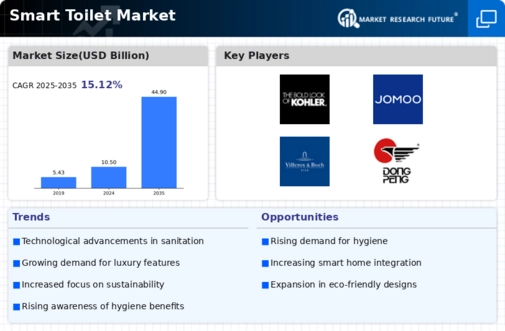Market Growth Projections
The Global Smart Toilet Market Industry is poised for substantial growth, with projections indicating a market value of 10.5 USD Billion in 2024 and an anticipated increase to 44.9 USD Billion by 2035. This growth trajectory suggests a compound annual growth rate of 14.09% from 2025 to 2035, reflecting the increasing adoption of smart toilet technologies worldwide. Factors such as rising hygiene awareness, technological advancements, and urbanization contribute to this upward trend. The market's expansion is likely to be supported by ongoing innovations and the introduction of new features that cater to evolving consumer needs.
Growing Focus on Sustainability
Sustainability emerges as a crucial driver within the Global Smart Toilet Market Industry, as consumers increasingly prioritize eco-friendly products. Smart toilets often incorporate water-saving technologies, which significantly reduce water consumption compared to traditional models. For example, dual-flush systems and efficient water management features contribute to lower utility bills and environmental impact. This focus on sustainability aligns with global efforts to conserve resources and reduce carbon footprints. As a result, the market is likely to witness a compound annual growth rate of 14.09% from 2025 to 2035, reflecting the growing consumer preference for environmentally responsible products.
Rising Demand for Hygiene and Sanitation
The Global Smart Toilet Market Industry experiences a notable surge in demand driven by increasing awareness of hygiene and sanitation. Consumers are becoming more conscious of the importance of maintaining cleanliness in personal hygiene, particularly in public and shared spaces. Smart toilets, equipped with features such as self-cleaning mechanisms and bidet functions, cater to this growing demand. As a result, the market is projected to reach 10.5 USD Billion in 2024, reflecting a significant shift towards products that enhance personal hygiene. This trend is likely to continue as urbanization and population growth further amplify the need for advanced sanitation solutions.
Technological Advancements in Smart Toilets
Technological innovation plays a pivotal role in the expansion of the Global Smart Toilet Market Industry. The integration of IoT technology, sensors, and automated features enhances user experience and convenience. For instance, smart toilets now offer personalized settings, remote control functionalities, and energy-efficient operations. These advancements not only improve user satisfaction but also contribute to water conservation efforts. As the market evolves, it is anticipated that the demand for technologically advanced smart toilets will propel the industry to a projected value of 44.9 USD Billion by 2035. This growth underscores the importance of continuous innovation in attracting consumers.
Increased Urbanization and Population Growth
Urbanization and population growth are critical factors influencing the Global Smart Toilet Market Industry. As more individuals migrate to urban areas, the demand for modern sanitation solutions rises correspondingly. Smart toilets, with their advanced features and space-saving designs, are particularly appealing in densely populated regions where traditional plumbing may be inadequate. This trend is expected to drive market growth, as urban centers increasingly adopt smart technologies to enhance living conditions. The projected market value of 10.5 USD Billion in 2024 illustrates the immediate impact of these demographic shifts on the smart toilet sector.
Rising Disposable Income and Consumer Spending
The Global Smart Toilet Market Industry benefits from rising disposable incomes and increased consumer spending, particularly in developing regions. As individuals gain more financial freedom, they are more inclined to invest in premium home appliances, including smart toilets. This trend is evident in emerging markets, where the adoption of luxury bathroom fixtures is on the rise. Enhanced consumer purchasing power is expected to contribute to the market's growth trajectory, with projections indicating a potential market value of 44.9 USD Billion by 2035. This shift suggests that economic development plays a significant role in shaping consumer preferences for advanced sanitation products.


 Source: Secondary Research, Primary Research, MRFR Database and Analyst Review
Source: Secondary Research, Primary Research, MRFR Database and Analyst Review










